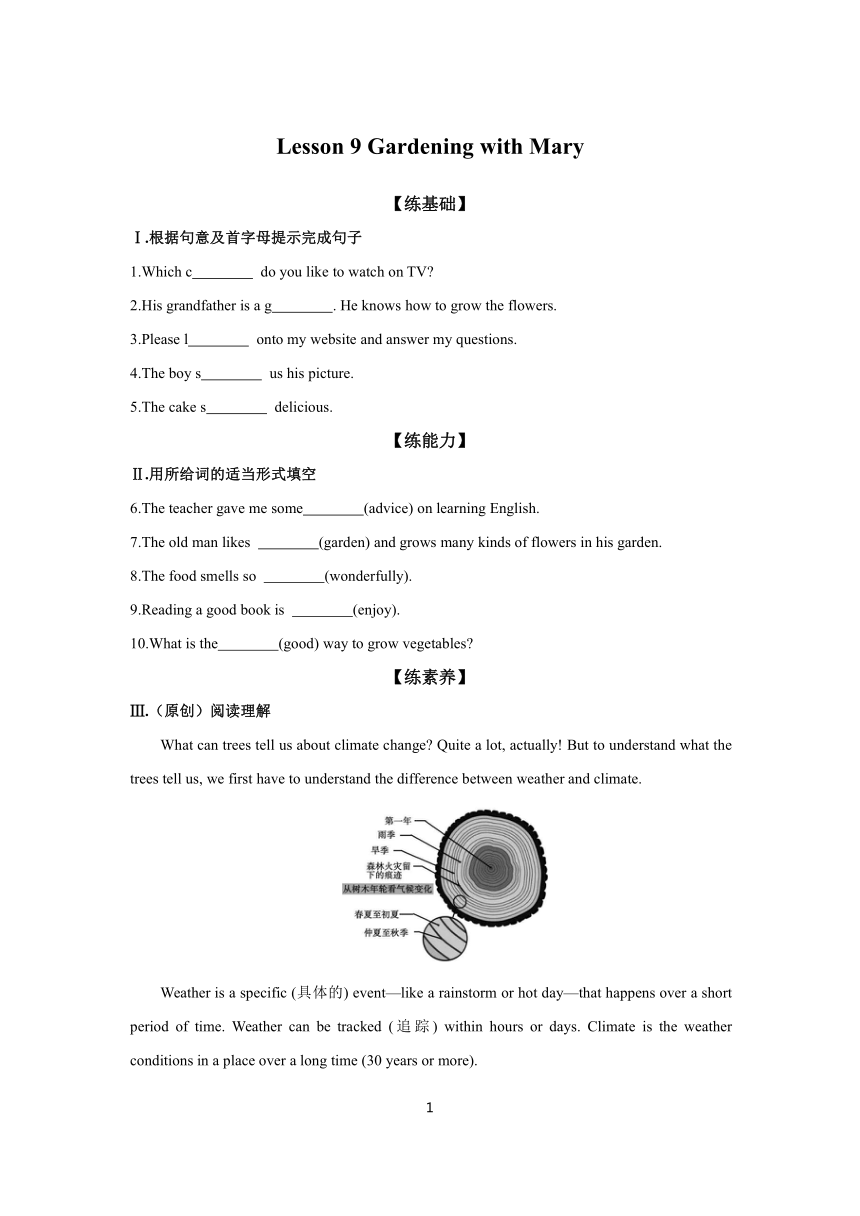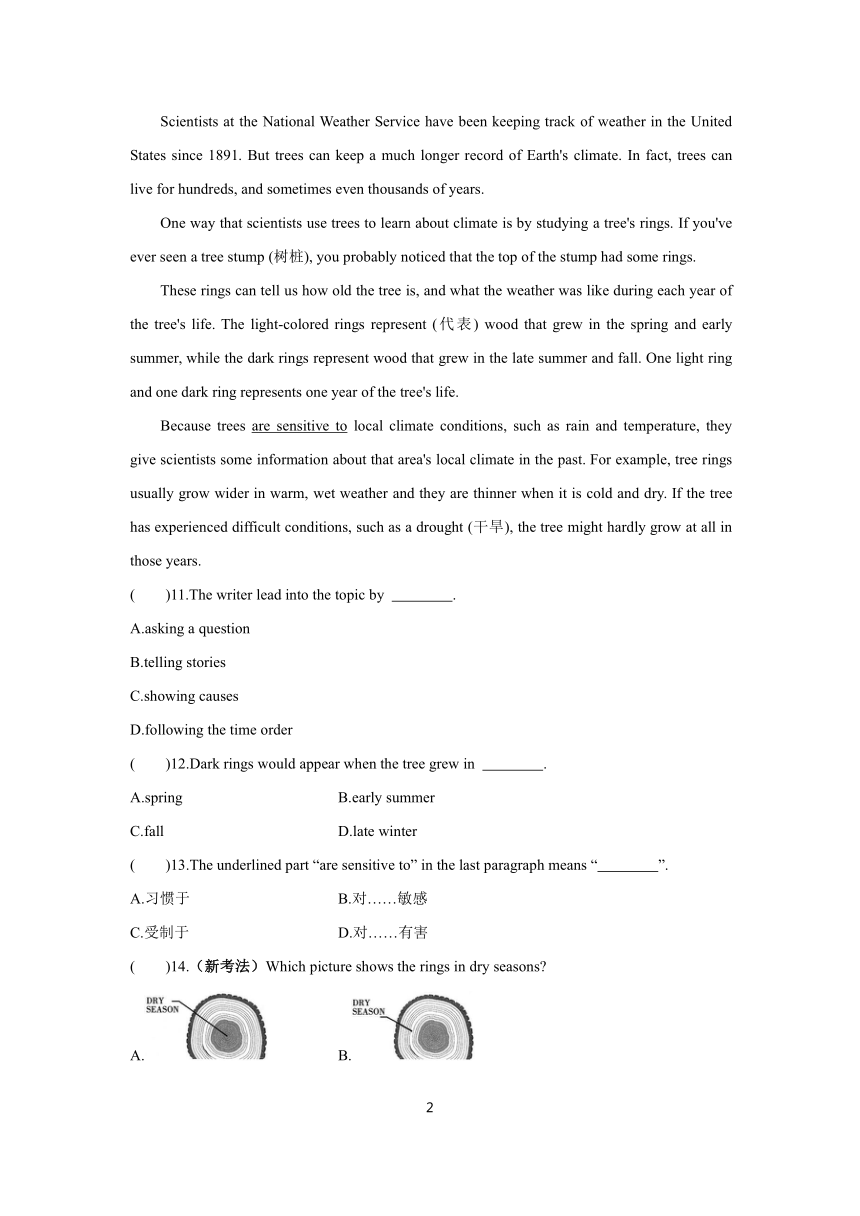Unit 2 Lesson 9 Gardening with Mary 同步练习 2023-2024学年冀教版英语八年级下册(含解析)
文档属性
| 名称 | Unit 2 Lesson 9 Gardening with Mary 同步练习 2023-2024学年冀教版英语八年级下册(含解析) |

|
|
| 格式 | docx | ||
| 文件大小 | 82.1KB | ||
| 资源类型 | 教案 | ||
| 版本资源 | 冀教版 | ||
| 科目 | 英语 | ||
| 更新时间 | 2024-02-22 12:17:29 | ||
图片预览


文档简介
Lesson 9 Gardening with Mary
【练基础】
Ⅰ.根据句意及首字母提示完成句子
1.Which c do you like to watch on TV
2.His grandfather is a g . He knows how to grow the flowers.
3.Please l onto my website and answer my questions.
4.The boy s us his picture.
5.The cake s delicious.
【练能力】
Ⅱ.用所给词的适当形式填空
6.The teacher gave me some (advice) on learning English.
7.The old man likes (garden) and grows many kinds of flowers in his garden.
8.The food smells so (wonderfully).
9.Reading a good book is (enjoy).
10.What is the (good) way to grow vegetables
【练素养】
Ⅲ.(原创)阅读理解
What can trees tell us about climate change Quite a lot, actually! But to understand what the trees tell us, we first have to understand the difference between weather and climate.
Weather is a specific (具体的) event—like a rainstorm or hot day—that happens over a short period of time. Weather can be tracked (追踪) within hours or days. Climate is the weather conditions in a place over a long time (30 years or more).
Scientists at the National Weather Service have been keeping track of weather in the United States since 1891. But trees can keep a much longer record of Earth's climate. In fact, trees can live for hundreds, and sometimes even thousands of years.
One way that scientists use trees to learn about climate is by studying a tree's rings. If you've ever seen a tree stump (树桩), you probably noticed that the top of the stump had some rings.
These rings can tell us how old the tree is, and what the weather was like during each year of the tree's life. The light-colored rings represent (代表) wood that grew in the spring and early summer, while the dark rings represent wood that grew in the late summer and fall. One light ring and one dark ring represents one year of the tree's life.
Because trees are sensitive to local climate conditions, such as rain and temperature, they give scientists some information about that area's local climate in the past. For example, tree rings usually grow wider in warm, wet weather and they are thinner when it is cold and dry. If the tree has experienced difficult conditions, such as a drought (干旱), the tree might hardly grow at all in those years.
( )11.The writer lead into the topic by .
A.asking a question
B.telling stories
C.showing causes
D.following the time order
( )12.Dark rings would appear when the tree grew in .
A.spring B.early summer
C.fall D.late winter
( )13.The underlined part “are sensitive to” in the last paragraph means “ ”.
A.习惯于 B.对……敏感
C.受制于 D.对……有害
( )14.(新考法)Which picture shows the rings in dry seasons
A. B.
C. D.
( )15.What is the text mainly about
A.The life of a tree.
B.Tree rings and seasons.
C.The need to plant trees.
D.Trees and climate change.
参考答案
练基础
1.channel 2.gardener 3.log 4.shows 5.smells
练能力
6. advice 7.gardening 8.wonderful 9.enjoyable 10. best
练素养
11~15 ACBCD
【主旨大意】本文主要介绍的是天气和气候的不同,以及树木的年轮所反映的生长环境的气候变化。
【答案与解析】
11.A 细节理解题。根据“What can trees tell us about climate change.”可知,作者是通过提问引入主题的。
12.C 细节理解题。根据“while the dark rings represent wood that grew in the late summer and fall”可知,深色的年轮代表了夏末和秋天生长的树木。
13.B 词义猜测题。根据“Because trees are sensitive to local climate conditions, such as rain and temperature”及“For example, tree rings usually grow wider in warm, wet weather and they are thinner when it is cold and dry.”可知,正因为树木对周围环境敏感,所以才能给人们了解气候变化提供信息。
14.C 细节理解题。根据“and they are thinner when it is cold and dry”可知, 当天气寒冷干燥时,年轮会变薄。
15.D 主旨大意题。通读全文可知,本文主要介绍的是天气和气候的不同,以及树木的年轮所反映的生长环境的气候变化。
2
【练基础】
Ⅰ.根据句意及首字母提示完成句子
1.Which c do you like to watch on TV
2.His grandfather is a g . He knows how to grow the flowers.
3.Please l onto my website and answer my questions.
4.The boy s us his picture.
5.The cake s delicious.
【练能力】
Ⅱ.用所给词的适当形式填空
6.The teacher gave me some (advice) on learning English.
7.The old man likes (garden) and grows many kinds of flowers in his garden.
8.The food smells so (wonderfully).
9.Reading a good book is (enjoy).
10.What is the (good) way to grow vegetables
【练素养】
Ⅲ.(原创)阅读理解
What can trees tell us about climate change Quite a lot, actually! But to understand what the trees tell us, we first have to understand the difference between weather and climate.
Weather is a specific (具体的) event—like a rainstorm or hot day—that happens over a short period of time. Weather can be tracked (追踪) within hours or days. Climate is the weather conditions in a place over a long time (30 years or more).
Scientists at the National Weather Service have been keeping track of weather in the United States since 1891. But trees can keep a much longer record of Earth's climate. In fact, trees can live for hundreds, and sometimes even thousands of years.
One way that scientists use trees to learn about climate is by studying a tree's rings. If you've ever seen a tree stump (树桩), you probably noticed that the top of the stump had some rings.
These rings can tell us how old the tree is, and what the weather was like during each year of the tree's life. The light-colored rings represent (代表) wood that grew in the spring and early summer, while the dark rings represent wood that grew in the late summer and fall. One light ring and one dark ring represents one year of the tree's life.
Because trees are sensitive to local climate conditions, such as rain and temperature, they give scientists some information about that area's local climate in the past. For example, tree rings usually grow wider in warm, wet weather and they are thinner when it is cold and dry. If the tree has experienced difficult conditions, such as a drought (干旱), the tree might hardly grow at all in those years.
( )11.The writer lead into the topic by .
A.asking a question
B.telling stories
C.showing causes
D.following the time order
( )12.Dark rings would appear when the tree grew in .
A.spring B.early summer
C.fall D.late winter
( )13.The underlined part “are sensitive to” in the last paragraph means “ ”.
A.习惯于 B.对……敏感
C.受制于 D.对……有害
( )14.(新考法)Which picture shows the rings in dry seasons
A. B.
C. D.
( )15.What is the text mainly about
A.The life of a tree.
B.Tree rings and seasons.
C.The need to plant trees.
D.Trees and climate change.
参考答案
练基础
1.channel 2.gardener 3.log 4.shows 5.smells
练能力
6. advice 7.gardening 8.wonderful 9.enjoyable 10. best
练素养
11~15 ACBCD
【主旨大意】本文主要介绍的是天气和气候的不同,以及树木的年轮所反映的生长环境的气候变化。
【答案与解析】
11.A 细节理解题。根据“What can trees tell us about climate change.”可知,作者是通过提问引入主题的。
12.C 细节理解题。根据“while the dark rings represent wood that grew in the late summer and fall”可知,深色的年轮代表了夏末和秋天生长的树木。
13.B 词义猜测题。根据“Because trees are sensitive to local climate conditions, such as rain and temperature”及“For example, tree rings usually grow wider in warm, wet weather and they are thinner when it is cold and dry.”可知,正因为树木对周围环境敏感,所以才能给人们了解气候变化提供信息。
14.C 细节理解题。根据“and they are thinner when it is cold and dry”可知, 当天气寒冷干燥时,年轮会变薄。
15.D 主旨大意题。通读全文可知,本文主要介绍的是天气和气候的不同,以及树木的年轮所反映的生长环境的气候变化。
2
同课章节目录
- Unit 1 Spring Is Coming
- Lesson 1 How's the weather?
- Lesson 2 It's Getting Warmer!
- Lesson 3 Sun Is Rising
- Lesson 4 The Spring City
- Lesson 5 Babysitting on a Spring Day
- Lesson 6 Stories about Spring
- Unit 2 Plant a Plant
- Lesson 7 Planting Trees
- Lesson 8 Why Are Plants Important?
- Lesson 9 Gardening with Mary
- Lesson 10 Make Your Garden Grow!
- Lesson 11 Amazing Plants
- Lesson 12 Danny's Plant
- Unit 3 Animals Are Our Friends
- Lesson 13 Danny's Big Scare
- Lesson 14 Amazing Animals
- Lesson 15 The Zoo Is Open
- Lesson 16 The Pear Escaped
- Lesson 17 Save the Tigers
- Lesson 18 Friendship Between Animals
- Unit 4 The Internet Connects Us
- Lesson 19 How Do You Use the Internet?
- Lesson 20 A Computer Helps!
- Lesson 21 Books or Computers?
- Lesson 22 Travel on the Internet
- Lesson 23 The Internet--Good or Bad?
- Lesson 24 An E-mail to Grandpa
- Unit 5 Buying and Selling
- Lesson 25 Raising Money
- Lesson 26 Cookies, Please!
- Lesson 27 Business English
- Lesson 28 Ms. Liu's Great Idea
- Lesson 29 How to Push a Product
- Lesson 30 A Cookie Sale
- Unit 6 Be a Champion!
- Lesson 31 Don't Fall, Danny
- Lesson 32 My Favourite Record
- Lesson 33 2800 Years of Sports
- Lesson 34 Modern Olympics
- Lesson 35 The Dream Team
- Lesson 36 Classroom Olympics
- Unit 7 Know Our World
- Lesson 37 Let's Learn Geography!
- Lesson 38 The World Is a Big Place
- Lesson 39 Ring Up or Call?
- Lesson 40 Body Language
- Lesson 41 A Class of the World
- Lesson 42 North America
- Unit 8 Save Our World
- Lesson 43 Let's Clean Up!
- Lesson 44 Environment Clubs
- Lesson 45 Let's Sort Garbage!
- Lesson 46 Protect Our Environment
- Lesson 47 Connected to Nature
- Lesson 48 Garbage Is Interesting!
